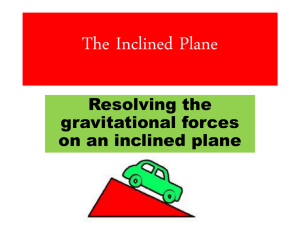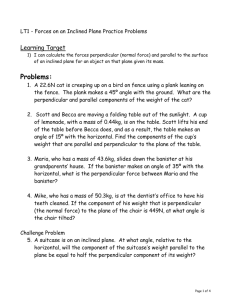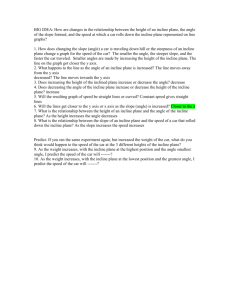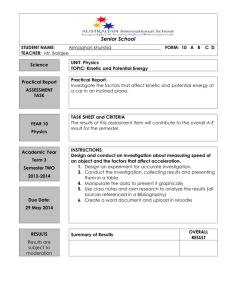Inclined Planes
advertisement
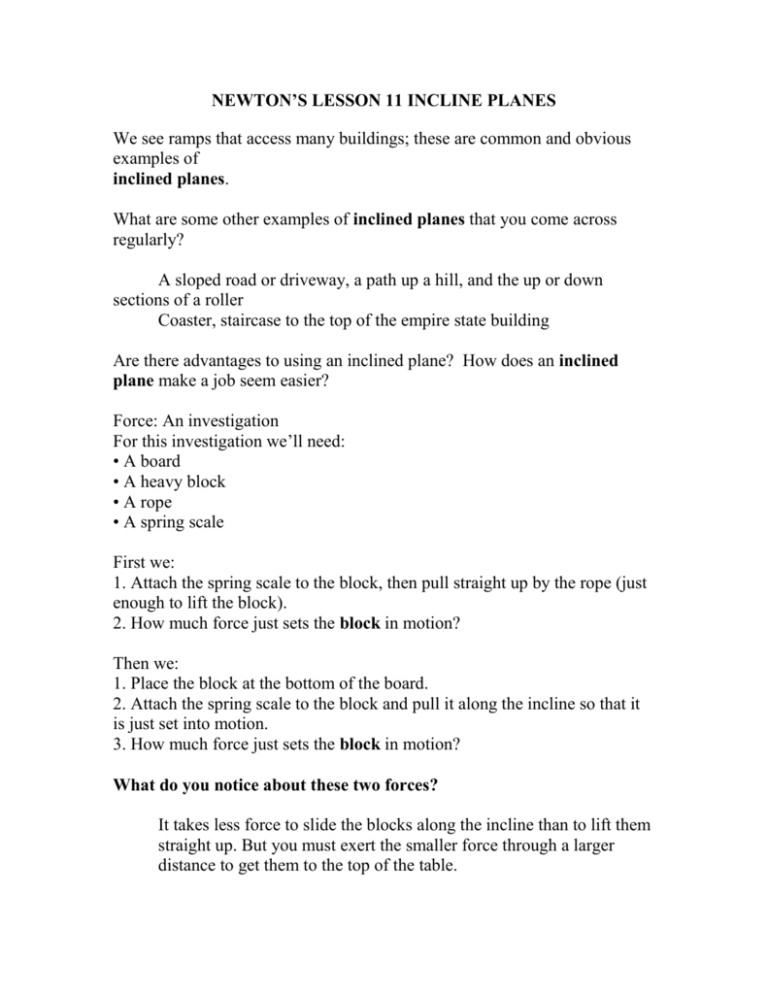
NEWTON’S LESSON 11 INCLINE PLANES We see ramps that access many buildings; these are common and obvious examples of inclined planes. What are some other examples of inclined planes that you come across regularly? A sloped road or driveway, a path up a hill, and the up or down sections of a roller Coaster, staircase to the top of the empire state building Are there advantages to using an inclined plane? How does an inclined plane make a job seem easier? Force: An investigation For this investigation we’ll need: • A board • A heavy block • A rope • A spring scale First we: 1. Attach the spring scale to the block, then pull straight up by the rope (just enough to lift the block). 2. How much force just sets the block in motion? Then we: 1. Place the block at the bottom of the board. 2. Attach the spring scale to the block and pull it along the incline so that it is just set into motion. 3. How much force just sets the block in motion? What do you notice about these two forces? It takes less force to slide the blocks along the incline than to lift them straight up. But you must exert the smaller force through a larger distance to get them to the top of the table. 1. Suppose you make the incline steeper, that is, make the angle of incline greater. How will that change the force you must exert to move the block along the incline? 2. Now suppose you make the incline less steep, that is, lay the board flat on the floor. How will that change the force you must exert to move the block along the board? The demonstrations show that as the angle of incline increases, the force required to move the blocks at constant speed increases, also. A thought investigation: So, you want to get the block to the top of the table. You know that you need to exert a smaller force to push or pull the blocks up the incline when the angle of incline is smaller. If the force to get the object to the table top decreases with a smaller incline angle, what is the trade-off? Distance is the trade off. The smaller the incline the longer the distance to move the object. The distance to move the block to the table top is shortest when the angle of incline is the largest, 90o to the table. The mechanical advantage of an inclined plane is the ratio of the length of the sloped surface to the height it spans. When the distance is vertical, mechanical advantage is 1. The higher the mechanical advantage, the less force is needed to push or pull the object to the required height. The ancient Egyptians figured this out over 3,000 years ago when they built their pyramids. They used long, shallow ramps to help them move the heavy stones to the top! INCLINE PLANES AND ACCELERATION An object placed on a incline plane will often slide down the surface. DEMO: Put a block on a plane and tilt it at varying degrees from horizontal to vertical. What do you notice? As the slope of the incline plane increases, what happens to the rate at which the object will slide down it? What happens when the incline is vertical? The acceleration on the object would be equal to the acceleration due to gravity. Objects are known to accelerate down inclined planes because of an unbalanced force. Two forces acting upon a crate which is positioned on an inclined plane (assumed to be friction-free). the force of gravity and the normal force. The force of gravity (also known as weight) acts in a downward direction; the normal force acts in a direction perpendicular to the surface (in fact, normal means "perpendicular"). The process of analyzing the forces acting upon objects on inclined planes will involve resolving the weight vector (Fgrav) into two perpendicular components. - one directed parallel to the inclined surface and - the other directed perpendicular to the inclined surface. The perpendicular component of the force of gravity is directed opposite the normal force and as such balances the normal force. The parallel component of the force of gravity is not balanced by any other force. This object will subsequently accelerate down the inclined plane due to the presence of an unbalanced force. It is the parallel component of the force of gravity which causes this acceleration. The parallel component of the force of gravity is the net force. EXAMPLE: A 5.0 kg mass is placed on an incline titled at 15º. 1. How much does the 5-kg mass weigh? Fg = ma = 5*9.8 = 49 N 2. Calculate the magnitude of the component that is acting parallel to the incline's surface? Fx mg sin (5.0kg)(9.8m / s 2 ) sin( 15) 12.68 N 3. Calculate the magnitude of the component that is acting perpendicular to the incline's surface? Fy mg cos (5kg)(9.8m / s 2 ) cos(15) 47.33N 4. At what angle would these two components be equal in magnitude? 45o 5. In which range of angles would Fx > Fy? (force down the ramp be greater than force into the surface of the ramp) (a) 0º<θ<45º (b) 45º<θ<90º Answer: (b) 45º<θ<90º Note that the steeper the slope, the greater the force pulling the box down the slope. Example: A 75-kg skier skies down a snowy slope of 25 degrees. Find the normal force, the net force, and the acceleration of the skier. Given: m 75kg, 25, g 9.8 m s2 Want: Fy ?, Fnet Fx ?, a ? Draw: A free-body diagram like the one above and label it. (I’ll leave this to you.) Use equations from earlier: Fy mg cos (75kg)(9.8m / s 2 ) cos(25) 666 N Fx mg sin (75kg)(9.8m / s 2 ) sin( 25) 310.6 N a g sin (9.8m / s 2 ) sin( 25) 4.14m / s 2 Example: Suppose you place a 10.0 kg box on a frictionless 30º inclined plane and release your hold, allowing the box to slide to the ground, a horizontal distance of d meters and a vertical distance of h meters. 1. What is the magnitude of the normal force? 2. What is the acceleration of the box? 3. What is the velocity of the box when it reaches the bottom of the slope if it takes 1.2 seconds to reach the bottom and it starts from rest? Answer: First, draw a free body diagram: 1. The box is not moving in the y direction, so the normal force must be equal to the y-component of the gravitational force. Calculating the normal force is then just a matter of plugging a few numbers in for variables in order to find the y-component of the gravitational force: FN = Fgy = mgcos30 =(10)(9.8)(cos 30) = 84.9 N 2. We know that the force pulling the box in the positive x direction has a magnitude of mg sin 30. Using Newton’s Second Law, F = ma, we just need to solve for a: Fnet = Fgx ma = mgsin 30 a = gsin30 = 9.8(0.500) 4.9 m/s2 3. We know the initial velocity, the time and acceleration: v f = v i + at v f = 0 + (5)(1.2) = 6.0 m/s HOMEWORK NEWTON’S LESSON 11 1. Two boys are playing ice hockey on a neighborhood street. A stray puck travels across the friction-free ice and then up the friction-free incline of a driveway. Which one of the following ticker tapes (A, B, or C) accurately portrays the motion of the puck as it travels across the level street and then up the driveway? Explain your answer. 2. Little Johnny stands at the bottom of the driveway and kicks a soccer ball. The ball rolls northward up the driveway and then rolls back to Johnny. Which one of the following velocity-time graphs (A, B, C, or D) most accurately portrays the motion of the ball as it rolls up the driveway and back down? Explain your answer. 3. A golf ball is rolling across a horizontal section of the green on the 18th hole. It then encounters a steep downward incline (see diagram). Friction is involved. Which of the following ticker tape patterns (A, B, or C) might be an appropriate representation of the ball's motion? Explain why the inappropriate patterns are inappropriate. 4. Missy dePenn's eighth frame in the Wednesday night bowling league was a disaster. The ball rolled off the lane, passed through the freight door in the building's rear, and then down the driveway. Millie Meater (Missy's teammate), who was spending every free moment studying for her physics test, began visualizing the velocity-time graph for the ball's motion. Which one of the velocity-time graphs (A, B, C, or D) would be an appropriate representation of the ball's motion as it rolls across the horizontal surface and then down the incline? Consider frictional forces. Explain your answer. 5. Three lab partners - Olive N. Glenveau, Glen Brook, and Warren Peace - are discussing an incline problem (see diagram). They are debating the value of the normal force. Olive claims that the normal force is 250 N; Glen claims that the normal force is 433 N; and Warren claims that the normal force is 500 N. While all three answers seem reasonable, only one is correct. Indicate which two answers are wrong and explain why they are wrong. 6. A car of mass 1100 kg rests upon an incline plane that is inclined at 10o to the horizontal. a. What is the weight of the car? b. Assuming that there are no frictional forces acting between the car and the surface on which it rests, draw a free-body diagram for the car. c. What is the magnitude of the normal contact force between car and inclined plane? d. What is the magnitude of the force acting on the car parallel to the plane? e. What is the acceleration of the car? 7. The weight of a book sliding down a friction-less inclined plane can be broken down into two vector components: one acting parallel to the plane, and one acting perpendicular to the plane. a) At what angle will these two components be equal? b) At what angle is the component parallel to the plane equal to zero? c) At what angle is the component parallel to the plane equal to the weight? d) As the angle goes up, how does the parallel component change? The perpendicular? 8. A 3.0 m long board has one end raised to a height of 60 cm to form an incline. A 4.0 kg mass is allowed to slide without friction down the entire length of the inclined plane. a. What is the final speed of the mass when it reaches the bottom ? b. If the mass is replaced with an 8.0 kg mass, what would be the new speed when it reaches the bottom? 9. A thin clothesline strung between fixed points 10.0 meter apart supports a single suit that weights 25 N. The suit is hung from the center of the line and this causes the line to sag 10.0 cm below the horizontal at this point. What is the tension in the line? 10. Finding her car stuck in the mud, a bright graduate of a good physics course ties a strong rope to the back bumper of the car, and the other end to a tree, as shown in the diagram. She pushes at the midpoint of the rope with her maximum effort, which she estimates to be a force Fapp = 300.0 N. The car just begins to budge with the rope at an angle θ (see diagram) which she estimates to be 5.0o. a. With what force is the rope pulling on the car? b. Was this method a good idea and is she a good physics student? c. What would happen if she continued to push on the rope? HOMEWORK KEY 1. B 2. Graph D 3. B 4. Graph D 5. Glen is correct 6. a. 1.08 x 104 N, b. no answer, c. 1.06 x 104 N, d. 1.87 x 103 N, e. 1.70 m/s, down the incline 7. a. 45o, b. 0o, c. 90o, d. increases, decreases 8. 3.4 m/s , no answer 9. 6.2 x 102 N 10. 1.7 x 103 N, see worked solution for b,c HOMEWORK NEWTON’S LESSON 11 1. Two boys are playing ice hockey on a neighborhood street. A stray puck travels across the friction-free ice and then up the friction-free incline of a driveway. Which one of the following ticker tapes (A, B, or C) accurately portrays the motion of the puck as it travels across the level street and then up the driveway? Explain your answer. Answer: B is the correct answer; it shows a constant velocity while traveling across the level surface (which is not shown in C) and it shows the deceleration which would be expected while traveling up a frictionless incline (which is not shown in A). 2. Little Johnny stands at the bottom of the driveway and kicks a soccer ball. The ball rolls northward up the driveway and then rolls back to Johnny. Which one of the following velocity-time graphs (A, B, C, or D) most accurately portrays the motion of the ball as it rolls up the driveway and back down? Explain your answer. Answer: Graph D is the correct answer. Initially, the ball has a northward velocity and is slowing down. For an instant in time, it has a zero velocity. Then the ball moves with a southward velocity (i.e., in the opposite direction) and speeds up. At all times the ball has a "negative" (southward) acceleration. These features are all depicted in Graph D. 3. A golf ball is rolling across a horizontal section of the green on the 18th hole. It then encounters a steep downward incline (see diagram). Friction is involved. Which of the following ticker tape patterns (A, B, or C) might be an appropriate representation of the ball's motion? Explain why the inappropriate patterns are inappropriate. Answer: B is the correct answer. Tapes A and C can both be ruled out since they show the golf ball moving with constant velocity across the frictional surface. The ball should be slowing down. Tape B shows an acceleration while moving down the hill which would be likely due to the presence of a parallel component of the weight vector. 4. Missy dePenn's eighth frame in the Wednesday night bowling league was a disaster. The ball rolled off the lane, passed through the freight door in the building's rear, and then down the driveway. Millie Meater (Missy's teammate), who was spending every free moment studying for her physics test, began visualizing the velocity-time graph for the ball's motion. Which one of the velocity-time graphs (A, B, C, or D) would be an appropriate representation of the ball's motion as it rolls across the horizontal surface and then down the incline? Consider frictional forces. Answer: Graph D is the appropriate representation. The ball will slow down due to friction while moving across the level surface and it will speed up due to the parallel component of the weight vector while moving down the incline. Graph D depicts both of these features. 5. Three lab partners - Olive N. Glenveau, Glen Brook, and Warren Peace - are discussing an incline problem (see diagram). They are debating the value of the normal force. Olive claims that the normal force is 250 N; Glen claims that the normal force is 433 N; and Warren claims that the normal force is 500 N. While all three answers seem reasonable, only one is correct. Indicate which two answers are wrong and explain why they are wrong. Answer: Only Glen is correct. Warren is incorrect because he evidently believes that the normal force is equal to the force of gravity. This is only true on level surfaces when the normal force is the only up force. Here the normal force is perpendicular to the surface and equal to the perpendicular component of gravity's pull. Olive is incorrect because she has evidently used the wrong equation for computing the perpendicular component of the weight vector. The parallel component is 250 N (m*g*sine 30 degrees). But the normal force is equal to the perpendicular component of the weight vector (m*g*cosine 30 degrees). 6. A car of mass 1100.0 kg rests upon an incline plane that is inclined at 10.0o to the horizontal. a. What is the weight of the car? b. Assuming that there are no frictional forces acting between the car and the surface on which it rests, draw a free-body diagram for the car. c. What is the magnitude of the normal contact force between car and inclined plane? d. What is the magnitude of the force acting on the car parallel to the plane? e. What is the acceleration of the car? Answer: a. b. c. d. e. Fg = weight = 1100*9.8 = 10780 N = 1.08 x 104 N No answer Fgy = FN = mgcosθ = 1100*9.8*cos 10 = 10616.227 = 1.06 x 104 N Fnet = Fx = mgsinθ = 1100*9.8*sin 10 = 1871.92 = 1.87 x 103 N Fnet = Fx ma = mgsinθ a = 9.8sin 10 = 1.7017 = 1.70 m/s 7. The weight of a book sliding down a friction-less inclined plane can be broken down into two vector components: one acting parallel to the plane, and one acting perpendicular to the plane. a) At what angle will these two components be equal? b) At what angle is the component parallel to the plane equal to zero? c) At what angle is the component parallel to the plane equal to the weight? d) As the angle goes up, how does the parallel component change? The perpendicular? Answer: a. 45o, b. 0o, c. 90o, d. increases, decreases 8. A 3.0 m long board has one end raised to a height of 60 cm to form an incline. A 4.0 kg mass is allowed to slide without friction down the entire length of the inclined plane. a. What is the final speed of the mass when it reaches the bottom ? b. If the mass is replaced with an 8.0 kg mass, what would be the new speed when it reaches the bottom? Answer Since Ff = 0, and FN is cancelled by Fy, Fx is the net force θ= sin -1( .6 / 3.0) = 11.3º a. Fnet = Fx ma = mgsinθ a = gsinθ a =(9.8)sin11.3º = 1.92 m/s2 Applying vf2 = vi2+ 2ad gives: vf2 = 0 + 2(1.92)(3.0) vf = 3.4 m/s b.In the equation a = gsinθ, we see that the acceleration of the object on the slope (in the absence of friction) does not depend on the object's mass. 9. A thin clothesline strung between fixed points 10.0 meter apart supports a single suit that weights 25 N. The suit is hung from the center of the line and this causes the line to sag 10.0 cm below the horizontal at this point. What is the tension in the line? First, determine the angle the clothesline makes with the vertical: θ = tan-1(5/0.1) = 88.85o Since the weight is 25 N. Each cable must pull upwards with 12.5 N of force. Thus, cos (88.85 degrees) = (12.5 N) / (Ftens). Proper use of algebra leads to the equation Ftens = (12.5 N) / [cos (88.85 degrees)] = 622.82 N = 6.2 x 102 N 10. Finding her car stuck in the mud, a bright graduate of a good physics course ties a strong rope to the back bumper of the car, and the other end to a tree, as shown in the diagram. She pushes at the midpoint of the rope with her maximum effort, which she estimates to be a force Fapp = 300.0 N. The car just begins to budge with the rope at an angle θ (see diagram) which she estimates to be 5.0o. a. With what force is the rope pulling on the car? b. Was this method a good idea and is she a good physics student? c. What would happen if she continued to push on the rope? Answer: a. Since the force applied is 300 N. Each cable must pull with 150 N of force. Thus, sine (5.0 degrees) = (150 N) / (Ftens). Proper use of algebra leads to the equation Ftens = (150 N) / [sin (5 degrees)] = 1721.056 N = 1.7 x 103 N b. Great idea and awesome physics student! She was able to magnify her effort almost six times using this technique! c. As she continues to push on the rope, the angle will increase and the force of tension on the rope will decrease. Therefore I would suggest that to maximize her results she would continually retie the rope taut in order to keep her efforts as productive as possible.

